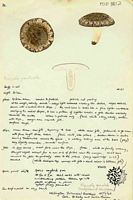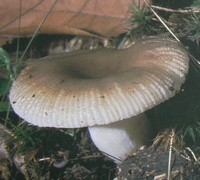|
 Russula pectinata Russula pectinata
BiostatusPresent in region - Exotic
Images (click to enlarge)
Caption: Watercolour
Owner: G.M. Taylor | 
Owner: P. Leonard |
Article: Stevenson, G. (1981). Antipodean association between Russula pectinata and planted limes. Bulletin of the British Mycological Society 15: 59-60.
Description: I had not seen this association, reported in Bulletins 12, 1978, 61-63 and 13, 1979, 33-34 until
30 April, 1978, when I came on an abundant eruption of R. pectinata under planted limes in
Central Park, Brooklyn Road, Wellington. A group of ten limes now about 30 cm dbh has been
planted on a slope beside the principal path about 130 metres from the main gate. The origin of
these trees is not known. The bank under the trees is mown regularly with adjoining areas though
the sward under the trees contains almost no grass but consists largely of Allium triquetrum,
Hydrocotyle sp. and moss. For some distance round these limes the steeply sloping terrain is
planted with other trees both exotic and indigenous, the whole area being well shaded.
Sporocarps were not counted but were recorded on the day of collection as `abundant under
limes'; an estimate from memory is that a total of at least 100 were seen under the 3 lower lime
trees. No other fungi were seen or collected near the spot but on the other side of the main
gully in Central Park a toadstool of similar appearance identified as R. pectinatoides was
found, several together under an endemic composite shrub, Brachyglottis rangiora growing
adventitiously under mature Pinus radiata introduced from California.
The R. pectinata specimens, my no. 78/29, agree closely with the description given in Les
Russules by Romagnesi: stipes tended to be short; the spore print had a cream tinge equalling
Romagnesi's blanchâtre, not as deeply coloured as in his description of the species. Likewise
the specimens from under the pines, my no. 78/25, which had a similar appearance of the cap,
agreed with Romagnesi's description of R. pectinatoides (A) var. type pectinatoides except that
the spore print which was sparse was white. Neither of these Russulas has been seen since, but
the two succeeding seasons have been poor for collecting and the area has not been under
continuous surveillance.
In New Zealand we have two distinct floras of vascular plants, the indigenous with a high
degree of endemism and the contrasting and largely very different exotic flora, about equally
numerous, which includes many common European plants together with a good number from
other places. The term exotic is used in New Zealand to cover what Professor Nannfeldt
defines as anthropochorous. Indigenous vegetation containing few to no exotic species still
covers large areas of mountain country but the settled and cultivated land is covered largely
by exotic plants. Over 100 years ago some introductions of living plants in soil were made but
most introductions of plants have been by seed. Nevertheless they seem to have brought their
own associated fungal partners. The abundance and range of the apparently introduced
toadstools has, in some cases, within my experience of about 40 years of sporadic collecting,
changed markedly. A few vascular plants immediately identifiable as exotic have the capacity
to invade indigenous vegetation which is all to some extent damaged by introducing grazing
animals. A few higher fungi may equally be invaders though identification as indigenous or
exotic cannot always be certain now. Dr Howard Lintott of Canterbury University has told me
that over the last decade he has watched Amanita muscaria extending steadily into the margin
of Nothofagus forest at Woolshed Hill in Arthurs Pass National Park. We need many more
careful records to document these interesting and continuing developments.
Notes: NOMENCLATURAL COMMENT
Readers of Greta Stevenson's article should perhaps be warned of the nomenclatural booby trap
that the couplet Russula pectinata - R. pectinatoides presents, and which results from the
disagreement in interpretations between different authors or even the same author. R.
pectinatoides Peck var. pectinatoides of Romagnesi in "Les Russules" is apparently the same
taxon as the R. pectinata (Bull. ex St. Amans) Fr. of the "New Check List of British Agarics
and Boleti", as well as of the "Flore Analytique" and of J. Schaeffer (Russula Monographie
1952). It is not the R. pectinatoides of the "Check List" nor that of the "Flore Analytique".
Romagnesi in "Les Russules" now refers this latter to R. livescens (Batsch) Quél.
The taxon Romagnesi calls R. pectinata is considered by him to be a different species from the
one of this name in the "Check List", mainly differing from it in the brighter, more yellowish,
i.e. pale ochre, colour of the cap, a similar hue to that of R. farinipes. It may occur in Britain
since I have seen specimens that possibly belong to it, but as far as I am aware, there are no
unequivocal records of its presence.
If Greta Stevenson was correct in referring the specimens she found under limes in New
Zealand to R. pectinata sensu Romagnesi and if he is correct in considering it a separate
species from his R. pectinatoides, then it follows that she was dealing with a different species
from that reported under limes by M.O. Moss since this was identified (and confirmed by
myself) as being R. pectinata sensu "Check List" i.e. the R. pectinatoides var. pectinatoides
of Romagnesi. The same applies to J.A. Nannfeldt's report since he states his R. pectinata was
sensu Cooke and J. Schaeffer, i.e. that of the "Check List".
If Greta Stevenson's fungus was indeed R. pectinata sensu Romagnesi, then the fact that it is
also associated with limes, in addition to the differences between it and his R. pectinatoides
being only small, may perhaps suggest that the two should not be considered separate species?
A further point in favour of this conclusion is that Romagnesi describes his R. pectinatoides
as rather variable and lists a number of forms and a variety.
A further complication is that Greta Stevenson found specimens that she identified as R.
pectinatoides var. pectinatoides sensu Romagnesi, i.e. the R. pectinata of the "Check List",
M.O. Moss and J.A. Nannfeldt, under pines!
This does, in fact, agree with my own observations that it may occur under conifers as well as
broad-leaved trees. Romagnesi also reports that it may be associated with both these types of
tree.
R.W. Rayner
|